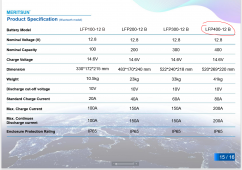Hello ladies and gentlemen, I just bought a 2016 Ford Transit Extended High Roof and am starting my build. I'm taking things slow and building it out as I go camping in it. Right now I'm setting up a primitive electrical system.
When I add solar, I'm thinking about going with about 900W of solar (3x300 watt panels in parallel). This will reach a maximum output of 75 amps. I plan on using a Victron MPPT Solar Charger. (I know it will be much lower due to efficiency and real world conditions. I live in Florida btw).
So, I'm thinking, hypothetically when I drive I may push up to (75 amps (solar) + 60 amps (DC->DC)) = 135 amps. I hear that the recomemnded charge rate of LiFePO4 batteries are ~0.2C, so that's (400 * 0.2) 80 amps.
So, that's the setup. Here's the question. How can I make sure my overall charge that goes into the battery does not exceed 80 amps? I know that some companies offer a complete package MPPT/DC to DC unit, but the highest amperage one I saw was a Renogy for 50 amps. Assuming I have multiple systems from different brands, how can I limit the charge amperage going into the batteries?
What if I connect a second 400AH in parallel to make a 12v/800AH system? Does that increase my maximum charging current to 160 amps or does it remain 80 amps? Thanks in advance to any replies.
- Battery 400AH 12v
- Link -> https://www.meritsunpower.com/merit...thhth-bms-for-marine-rv-solar-system-golf-car.
- Price is $1275 USD before shipping FYI.
- DC to DC Charger (charging from Transit's Vehicle Batteries/Alternator)
When I add solar, I'm thinking about going with about 900W of solar (3x300 watt panels in parallel). This will reach a maximum output of 75 amps. I plan on using a Victron MPPT Solar Charger. (I know it will be much lower due to efficiency and real world conditions. I live in Florida btw).
So, I'm thinking, hypothetically when I drive I may push up to (75 amps (solar) + 60 amps (DC->DC)) = 135 amps. I hear that the recomemnded charge rate of LiFePO4 batteries are ~0.2C, so that's (400 * 0.2) 80 amps.
So, that's the setup. Here's the question. How can I make sure my overall charge that goes into the battery does not exceed 80 amps? I know that some companies offer a complete package MPPT/DC to DC unit, but the highest amperage one I saw was a Renogy for 50 amps. Assuming I have multiple systems from different brands, how can I limit the charge amperage going into the batteries?
What if I connect a second 400AH in parallel to make a 12v/800AH system? Does that increase my maximum charging current to 160 amps or does it remain 80 amps? Thanks in advance to any replies.



